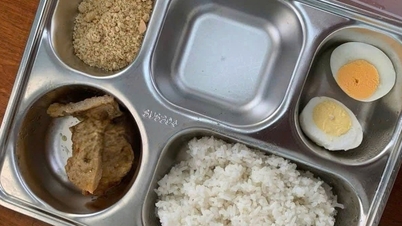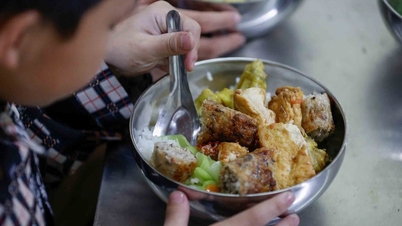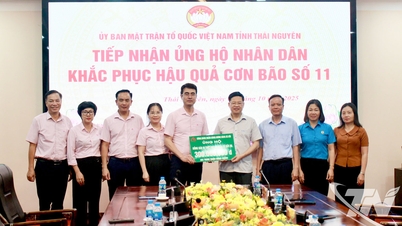
Over the years, the average height of children in Ho Chi Minh City has continuously increased - Photo: TTD
School meals provide energy and nutrients necessary for children's comprehensive development, especially height growth.
From standard meals to individual nutritional ration
At noon on October 7, we were at Dinh Tien Hoang Primary School, Tan Dinh Ward, Ho Chi Minh City, when the students were having their lunch. Each table had four students sitting together, each with their own tray.
Today’s menu included pork in tomato sauce, stir-fried vegetables, and spinach soup. On each table, a pot of vegetable soup was available for students to add to if they wanted.
This lunch of Dinh Tien Hoang Primary School students is made according to the Standard School Nutrition Menu - a program on standard boarding meals of the Department of Education and Training of Ho Chi Minh City that started in 2012. Therefore, it is a "nutritious" lunch consisting of four dishes and four groups of substances that are weighed - measured - counted and almost never repeated within two weeks.
This work is carried out smoothly with careful constraints from the food supplier, checked, quantified, and quality controlled by the school's weighing and measuring department and the medical department.
Ms. Tran Thi Thu Huong, the school principal, informed that after six years of providing nutritious meals for students, the meals have generally been warmly received by students and parents. What is special is that the school also provides nutritious meals for obese and malnourished students. Obese or malnourished students are arranged to eat first by the school to implement their own nutritional standards.
"Meals play an important role in children's development. Therefore, we always work with parents and coordinate with them to ensure that children have similar meals in the morning and evening so that they can develop best. I am happy that now many parents at the school really understand the importance of meals for children and coordinate well with the school in implementing nutrition from school to home," Ms. Thu Huong expressed.
Nguyen Binh Khiem Primary School, Ho Chi Minh City has also provided nutritious meals for students for many years. In particular, the school has a kitchen at the school, so providing nutritious meals according to the menu prescribed by the Ho Chi Minh City Department of Education and Training is more convenient.
Each meal of the students here also follows the nutritional standards, must have enough protein, vitamins, minerals, fat, fiber necessary for their age. Students will eat according to the prescribed portion and the menu is informed to parents every week.
In addition, to strictly comply with the menu and nutritional rations, Nguyen Binh Khiem Primary School also invites parents to have lunch with the students according to the parents' needs.
Parents only need to register in the morning with the homeroom teacher. At noon, parents can sit at the table with their children to see "how good the quality of lunch is".

Students of Dinh Tien Hoang Primary School during lunchtime - Photo: M.DUNG
Essential for the comprehensive development of children
According to Dr. Do Thi Ngoc Diep - former Director of the Ho Chi Minh City Nutrition Center, over the past years the average height of children in Ho Chi Minh City has continuously increased. Every five years, children of the same age have an average height higher than before.
School meals have many benefits. In terms of nutrition, school meals provide energy and many nutrients to meet the needs of learning, exercise, physical and mental development according to age, including height growth.
When school meals are prepared according to guidelines, recommendations and nutritional standards, they will ensure food diversity, balance nutrient groups, limit excessive salt and sugar intake and vitamin and mineral deficiencies, thereby helping to control nutrition-related diseases such as malnutrition, micronutrient deficiencies, overweight and obesity.
In terms of behavior, school meals play an important role in building healthy nutritional habits that are beneficial to students' health... In remote areas, school meal programs not only help improve nutrition but also encourage children to go to school.
According to Ms. Diep, Vietnam has been and is continuing to develop Nutritional Guidelines for School Meals to provide nutritional recommendations for school meals based on the principle of providing adequate energy and necessary nutrients, balanced and diverse foods to help students develop physically, contributing to improving the quality of future human resources for the country.
She added, "Ho Chi Minh City is at the forefront of the country in developing a nutritional menu system and training and implementing nutritional guidelines for school meals at all levels." However, in reality, as reported by the press, there are still some establishments "cheating", cutting down on portions or ingredients, so it requires further monitoring to ensure the quality of meals for students.
Model of strict school meal management
Although Singapore implemented it later, it stands out for its strict management model. In 2011, the "Healthy School Meals" program (HMSP) was developed by the National Health Agency in collaboration with the Ministry of Education , setting out specific standards for portions and proportions of food groups in meals.
Accordingly, each meal in school must have at least one portion of vegetables, fruits and whole grains. At the same time, healthy cooking methods such as boiling, steaming, reducing sugar, salt and fat are also strictly applied.
This policy not only significantly improves the quality of school meals but also contributes to building healthy eating habits from a young age. According to CNA, thanks to these adjustments, the rate of overweight children in Singapore has decreased significantly, while the average life expectancy of the people has also increased to about 83.5 - one of the highest numbers in Asia.
Asian countries' experiences in improving school meals
Japan is one of the first countries in Asia to build a systematic and large-scale school meal program.
According to the Global Child Nutrition Foundation (GCNF), since 1954, Japan has implemented the National School Lunch Act to provide safe, nutritious meals for public elementary and junior high school students. In particular, in 2005, the "Basic Law on Food and Nutrition Education" (Shokuiku) was enacted, with the goal of forming healthy eating habits from an early age.
Meals are designed by experts to ensure balance and nutrition, and are accompanied by practical educational activities such as eating together, cleaning up, and sorting trash, helping children understand and appreciate the value of food. The success of the school meal program in Japan is clearly demonstrated through impressive numbers.
According to a 2023 survey by the Japanese Ministry of Health , Labor and Welfare, the average height of men has increased to 1.72m, and that of women to 1.58m, compared to 1.5m and 1.49m, respectively, in 1970. At the same time, Japan also leads the world in life expectancy, with an average of over 84 years old.
In Korea, the School Meal Act was passed in 1981, along with the Integrated School Meal System to strictly manage menus, nutritional information, food safety guidelines, and allergy management. A nutrition teacher system was also implemented in 2006 to ensure meals are age-appropriate.
According to the Korea Times, school meals in Korea are not just simply filling, but are extremely rich and diverse with rice, soup, side dishes (banchan), kimchi and seasonal vegetables. Therefore, these meals are praised as "the best school lunches in the world".
In terms of nutrition, data from CEIC Data shows that the rate of stunted children under 5 years old in Korea is only 1.7% - a very low number compared to many countries in the region. Surveys in 2022 also recorded the rate of mild underweight in elementary and middle school students at only about 2-3% - proving the outstanding effectiveness of the school nutrition program.
**************
>> Part 3: Cannot live long if meals are dirty and the environment is polluted
Source: https://tuoitre.vn/chuan-dinh-duong-hoc-duong-de-the-he-tre-viet-nam-khoe-manh-20251010084053401.htm


![[Photo] Unique Phu Gia horse hat weaving craft](https://vphoto.vietnam.vn/thumb/1200x675/vietnam/resource/IMAGE/2025/10/10/1760084018320_ndo_br_01-jpg.webp)

![[Photo] Ho Chi Minh City is brilliant with flags and flowers on the eve of the 1st Party Congress, term 2025-2030](https://vphoto.vietnam.vn/thumb/1200x675/vietnam/resource/IMAGE/2025/10/10/1760102923219_ndo_br_thiet-ke-chua-co-ten-43-png.webp)
![[Photo] Opening of the World Cultural Festival in Hanoi](https://vphoto.vietnam.vn/thumb/1200x675/vietnam/resource/IMAGE/2025/10/10/1760113426728_ndo_br_lehoi-khaimac-jpg.webp)















![[Video] Ho Chi Minh City: Many subjects still lack teachers](https://vphoto.vietnam.vn/thumb/402x226/vietnam/resource/IMAGE/2025/10/10/1760108638254_gv-png.webp)

















































































Comment (0)